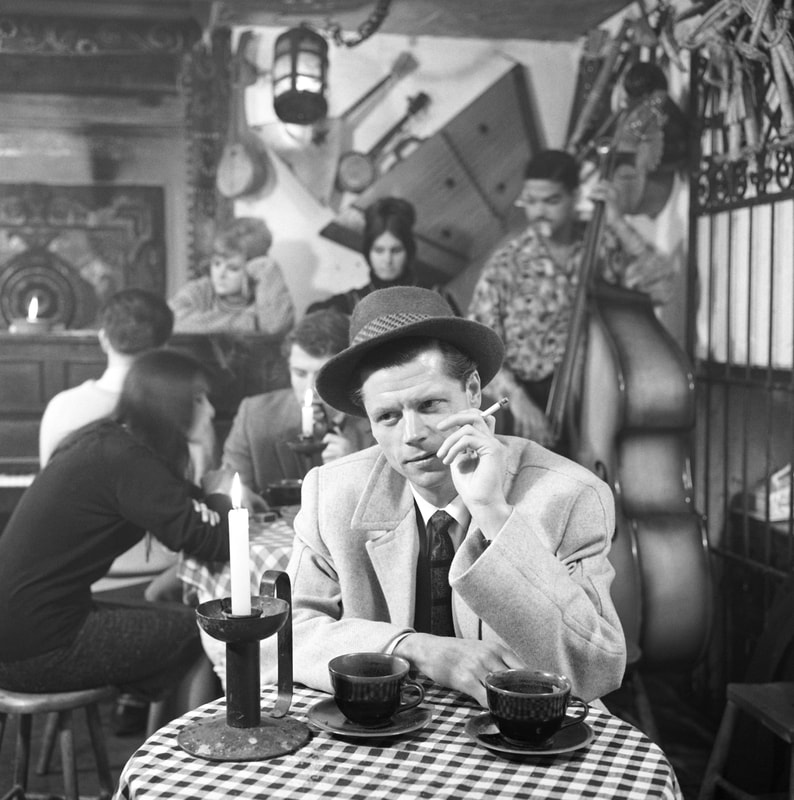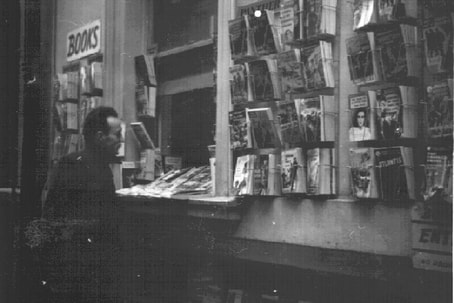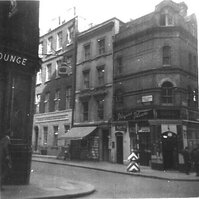|
‘The Group’ in Soho In the 1950s, London was there for the taking. It was bomb-damaged, impoverished and dirty, but it was also cheap, cosmopolitan and – in the area of Soho – a stimulating environment. Anyone could make their way into this raffish district and hope to get by. Here, you could drift around the cafes, make friends, maybe find casual employment and somewhere to doss down for the night. Those who became members of ‘the Group’ mostly arrived this way. The coffee bar scene, characterised by the hiss of espresso machines, and the steam of frothy milk, was growing fast. One Signor Riservato, a dental-equipment salesman from Italy, was the unlikely founder of this craze. Arriving in England to sell his wares, he was disgusted by what passed for coffee here. He switched his stock to sell Gaggia espresso machines, and opened his own café, the Moka Bar, which was the first to kick off the Soho coffee bar craze.[i] The founders of the Group - Alan Bain, Glyn Davies and Tony Potter – held court, singly or together, in a few selected coffee bars. ‘The Florence’ and ‘the Cross’, both in in Villiers St by Charing Cross, and the 2 Gs (The Gyre and Gimble) were favourites, although Lyons Corner House was also a regular venue, perhaps because of its cheap eats. Even budding Kabbalists could not live on coffee alone. ‘You could have Spag Bol for 2s 3d round there,’ reminisced early group member Keith Barnes fondly. Then there were cafés known more as the haunts of musicians, such as the Nucleus, nicknamed ‘the Nuke’, which also became part of the circuit - Alan Bain was himself a musician, playing the accordion professionally. Other ‘creatives’ from the world of advertising and film-making also began to frequent post-war Soho. Two of the early group members worked in an advertising agency, and Walter Lassally, who was then at the start of his distinguished career as a cinematographer, found the embryo ‘Group’ while visiting Soho, quite possibly in connection with film shooting or post-production studios. ‘The Nucleus was the centre of it all, the coffee bar in Monmouth Street. And someone was always in there holding forth, mainly Potter. Potter was great at holding forth, whereas Alan was really quite reticent.’[ii] Musicians turned up on the fringes of the group who were already rising stars, or about to become so: Red Sullivan, Davy Graham and Diz Disley hung out in cafes where Tommy Steele was also beginning to make himself a name. Keith Barnes, too, liked to busk in the musician’s cafés, as well as frequenting the more regular Group haunts. And here’s what Lionel Bowen had to say: ‘I spent a lot of time in the ‘Gyre and Gimble’ coffee house on John Adam Street close to Trafalgar Square. We drank espresso, played bad guitar and sang (poorly) folk songs. The elder members of the Group hung out there, on the lookout for likely recruits (of which I was one). My generation of the Group met in three different restaurants: Joe Lyons Corner House in the Strand, The Cross and the Florence on Villiers Street. Where we met depended on how much money we had at any one time. The Florence Cafe was the best, but we had to order a meal to sit there for any length of time. We read The Mystical Kabbalah, traded lists of attributes with each other and fixed the world, as young idealists are prone to do.’ Exciting times! Soho society then was a mix of truth-seeking youngsters, creative artists and original thinkers, but along with that went prostitutes, heavy protection rackets, and homeless runaways, many of whom were in trouble.[iii] Group members took their responsibilities seriously: ‘Some of those we met in the cafes were young girls who had run away from home or were wanted in court. Usually we managed to talk them into going back home, or facing up to whatever they were running away from,’ Keith Barnes reported. And the members themselves often lived hand to mouth. In a way, this was part of the Bohemian tradition that had also coloured Soho before the war – not being tied down, taking a berth for the night wherever you could find it, scavenging for cheap or free food and earning money only when you had to. The recently-discovered memoirs of Ironfoot Jack, himself a colourful character with a vague interest in Occultism, paint a vivid portrait of Bohemian life and getting by in Soho in the 20s and 30s.[iv] Sleeping out and living rough did carry a certain romanticism. Even the writer Colin Wilson, who had a passing association with the Group, slept out on Hampstead Heath, making sure his photograph was taken there. Ernest Page, who taught Alan Bain and other Group members astrology, was often homeless, and died on a park bench. He was a man of many parts, however, as an accomplished poet and a key helper in what became the Simon Community, a charity supporting London’s homeless people. If Keith Barnes was short of a bed or a friend’s floor to sleep on, he would usually go to one of the all-night cafes. Mick’s in Fleet St was a favourite. ‘You would often see quite famous musicians bombing along there in Ford vans driving at 70mph delivering newspapers – they took on these jobs because they couldn’t earn enough from their music.’ [v] Keith and Glyn Davies shared several flats together, just about making ends meet. Keith recalled how they would go and scrounge a bone ‘for the dog’ from Smithfield, then head to Covent Garden late afternoon to pick up fruit and veg from the ground, which was there for the gleaning. Glyn always had a pot on the go, into which he would throw the bone and the veg. ‘Very tasty!’ Rented rooms were usually very basic: in Kentish Town Keith and Glyn were plagued with mice, but Glyn used to leave the oven door open to keep the mice warm at night! Sometimes people made shift in more unorthodox ways Alan Bain slept in a kind of office that he rented near Charing Cross, and folded up his blankets every morning so that the landlord wouldn’t know. Occasionally, dawn saw a few Group members heading off to Brighton on the earliest train for a quick frolic by the seaside – once, in Glyn’s case, to plunge into the waves with the aim of shrinking his new blue jeans! An old type of train fare, formerly known as a ‘workman’s ticket’ and now re-named an ‘early morning return’, made such jaunts possible for cash-strapped Group members.[ For those not on a career path, such as advertising or film-making. paid jobs were generally taken out of necessity, though sometimes interesting in their own way. Both Alan and Glyn became book-sellers. Alan recalled that he opened “Bain’s Bookshop” in a room above the Gyre & Gimble with £24 pounds borrowed from Glyn. And Glyn ran a portable bookstall, using wheelable book cases, and sold his books late into the night, after the shops closed. His regular pitch was outside St Martin in the Fields, but he also plied his trade outside Foyle’s bookshop. One night, its owner, Christina Foyle, emerged and, much to his surprise, asked him politely how business was going! Sometimes, however, more mundane jobs like dishwashing or clerking in an office had to be taken up. On one occasion, Glyn announced to his flat-mate Keith, that he had a job interview the next day. The only problem was that he only had one outfit - Keith was asked to get his suit and shirt cleaned while Glyn stayed put, wrapped in a blanket!
So the coffee bars were not only places to hold philosophical discussions. They were where you could get warm, have something cheap to eat, and pick up tips about jobs, musical gigs and rooms to rent. And perhaps do a little bit of good for those who were looking lost. ‘In the coffee bars or at gatherings, if someone came along who just needed ten shillings to get home, then the advice was to give it to them. Help them on their way. But if they came back, looking for something, and showed interest, then you would introduce them to another member of the group.’ (Keith Barnes). No one was pressurised to join the Group, although Tony Potter could be very persuasive. ‘Tony was a kind of front man, fond of holding forth, especially in front of adoring young women’. (Walter Lassally). And what if you did join? Well, for a while you might be just a part of the mix, turning up at one of the coffee bars, joining in the debates, and learning a little about Kabbalah and astrology. Then, when you w[i]ere judged to be ready, you would be handed a slip of paper with a date, time and address on it. And, as the old saying goes, ‘This is then the work really begins.’ Cherry Gilchrist Part II will explore the workings of the early Group behind closed doors. i Article by Dr Matthew Green: ‘Coffee in a Coffin: The fascinating story of Le Macabre – and Soho’s 1950s espresso revolution’. Daily Telegraph Mar 9th 2017 https://www.telegraph.co.uk/travel/destinations/europe/united-kingdom/england/london/articles/the-amazing-story-of-soho-1950s-espresso-revolution/ iinterview with Walter Lassally, Suffolk 2014, by Rod Thorn and Cherry Gilchrist iii For an overview of Soho at the time, I recommend Soho in the Fifties by Colin Farson (Michael Joseph, 1987) iv The Surrender of Silence: The Memoirs of Ironfoot Jack, King of the Bohemians’ edited by Colin Stanley (The MIT Press, 2018) v Recollections shared by Keith Barnes during several conversations with Cherry Gilchrist. Cherry and Keith were members of a Kabbalah group together, run by Glyn Davies, 1970-72. Cherry Gilchrist
1 Comment
|
AuthorsArticles are mostly written by Cherry and Rod, with some guest posts. See the bottom of the About page for more. A guide to all previously-posted blogs and their topics on Soho Tree:
Blog Contents |
Proudly powered by Weebly









 RSS Feed
RSS Feed